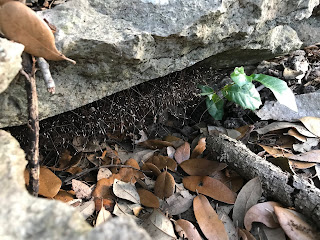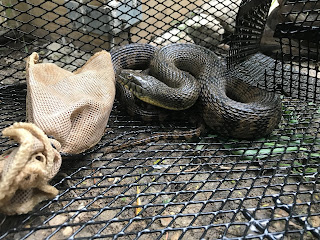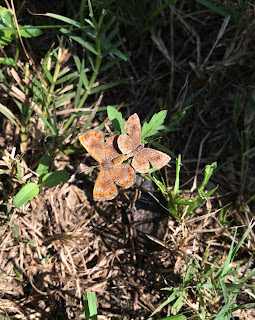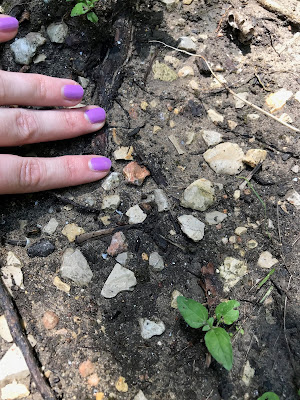Our ribbon snakes remain elusive in the field despite starting to put out minnow traps and reports of them being common. So in line with the purpose of the this blog, here are some of the other fun things we have seen in our quest for snakes!
One of our study sites had several small waterfalls:
Here is another #FindThatToad challenge! It is another tiny one!
The hill from the stream to the lake, was covered in bright purple horsemint (also called beebalm). It is unusual for them to still be this vibrant and green this time of year. But we have been getting a lot of rain this year, which probably has something to do with it. Fun fact: this plant can act as a natural insect repellent and may have citronellol in its leaves (conflicting information about that).
We saw a couple of different types of milkweed. Milkweed is most famous for being a host for monarch caterpillars. They disperse their seeds using wind and the fluffy fibers seen in the picture below. The seed fibers are super soft!
We started setting minnow traps at one site for several days over the last couple of weeks. This site has two resident diamonback watersnakes (not to be confused with diamondback rattlesnakes). We named them (because why not)! The larger, lighter one is Henri and the smaller, darker one is Ryan. Pictured below is Henri getting very excited about the sardines in our minnow traps (you can see their face on top of the trap)! Thankfully Henri did not get stuck, we had no interest in trying to get them back out....
We visited this site several times and sometimes walked around the site looking for basking snakes. In the process, we found this impressive collection of harvestmen (daddy long-legs) under a rock ledge.
I also managed to get this glamor shot of a small toad. No posing needed. I love how superior toads always seem to be, as if they are above it all.
And another picture of Henri being interested in our traps on a different morning, but not inside them.
The first morning we had the trap in this location, Ryan seemed to be using it as a hunting ground. They would stick their head inside the trap and wait there....
We went back to Jackson Nature Park, just to look around and found a partial snake skin shed, so they must be around! We also found this adorable juvenile gray treefrog (Hyla chrysoscelis), but it was bright green! They went so well with my "Got Frogs?" hat! #ScientistsWhoSelfie
Morgan spotted this HUGE ant on the ground. At first we thought it was a beetle (because of the size), but it is probably a Texas Leafcutter Ant (Atta texana). I had no idea they were around! What a fun find!
We spotted these mating butterflies, posed perfectly in the sun. Mating makes butterflies especially vulnerable to predators. They didn't move while we took pictures, but I imagine it would be hard to fly like that!
While we are on the topic of cool bug encounters, we saw a dragonfly carrying a butterfly! I tend to forget they are predators... (It is in this photo, I promise...near the center!)
Had a photoshoot with a larger toad, again note the look of superiority.
We also discovered another master of crypsis (camouflage): The wavy-lined emerald moth caterpillar! These little insect larvae cover themselves in flower petals, leaves, and other materials to blend in! Check out what the adults look like here. I am honestly not quite sure how I spotted these two (the last picture is a different one), but it makes me more confident that I am not missing snakes that are actually there...
As a side note, if anyone was wondering, the toad from the last post is an 80% color match with the mud next to it! Quantitative ecology is so cool!

































































